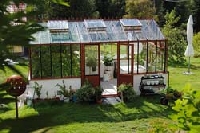Where to set up a greenhouse
By Catalogs Editorial Staff

Figuring out where to set up a greenhouse has more to it than you might think!
Expand your gardening horizons with a greenhouse in your yard. Gardeners can grow plants and crops for a longer period of time because greenhouses are the ultimate in season stretchers, bringing spring earlier and delaying winter. So, during the bitterest chill of winter, you can still grow hardy plants, such as kale and other greens.
If this appeals to you, some key information can help make that greenhouse a reality because there are many things to consider besides sunlight.
When choosing a greenhouse, buy the best one you can afford. A flimsy plastic version might look nice to the wallet, but one good wind and it will blow away. Another option is to find a gently used greenhouse, since you might be able to get a lot more house for much less money.
The foundation the greenhouse will stand on is important. Look for a fairly level area to avoid the cost of filling or digging to make a level location. Unless you?re setting up on an old tennis court, chances are good that you?ll have to prepare a basic foundation and floor for your greenhouse. Some models come with a floor that only needs to be set on brick or concrete feet. Others need to be set on an existing firm base.
~
Water is a critical resource to have available, as anything you are growing will need to be watered. A permanent underground water line is the ultimate luxury, while a temporary garden hose will do.
If you are in a rainy area, consider catching the rain in a barrel and using that for your plants. They will appreciate the nutrients in the rain and you?ll like not having to pay a higher water bill. For any water source, be sure to protect the system from freezing with insulation, heat, or by draining the system for the cold seasons.
Electricity can provide heat, ventilation and lighting to make the greenhouse more comfortable for your plants ? as well as for you. Heat, especially if you are growing through the winter, is necessary to ensure your plants don?t freeze. Ventilation is important, particularly during the warmer months. This way, excess heat and humidity can be replaced with fresh air instead of roasting or rotting your tender plants. Lights are useful for being able to see or for giving plants extra light for growing.
If electricity isn?t available, you can use a wind-powered roof ventilator to move air, mount a black surface about a foot behind a clear window with a fan for solar heat, and solar-powered landscape lamps can provide basic lighting.
Obviously, sunlight is essential. It?s best if your greenhouse can get at least six hours of sun a day. If you have plants against a southern-facing wall, you?ll need shade cloth because it can get too sunny for your plants, especially tomatoes and peppers.
To optimize your greenhouse, position it so the length of the structure is running east to west. This orientation maximizes heat gain during the winter and minimizes the southern exposure.
If your greenhouse is a focal point in your yard, make the most of it. Have a trellis or potted plants on either side of the door. A nice bench for sitting and a birdbath or water fountain are also great features to add. Visitors are likely to make a beeline to see it and it gives you a beautiful place to relax. Inside the structure, make sure you have enough workbenches, shelves and storage for your gardening endeavor.
There are many details to consider for setting up a perfect greenhouse: a sturdy house, solid level foundation, water, ventilation, electricity, and good sunlight. Don?t forget to make it a house to be proud of with well-chosen and well-maintained features. Once you have all this sorted out, you?re good to grow!
Popular Savings Offers











